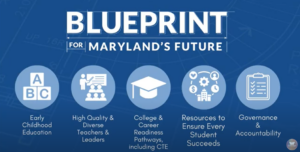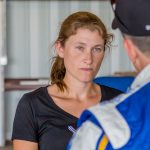
SNOW HILL– Education officials outlined changes tied to the new Blueprint for Maryland’s Future with the Worcester County Commissioners this week.
On Tuesday, Worcester County Public Schools (WCPS) leadership outlined the five pillars associated with the Blueprint for Maryland’s Future. While salary increases, expanded dual enrollment offerings and more social workers are among the changes expected, officials stressed that the Blueprint was constantly changing.
“We’re just giving you probably the worst-case possibility as far as expense,” Superintendent Lou Taylor said. “A lot of this is far from being decided. It’s what’s proposed. We wanted you to know the full extent of it… There are some things I don’t think will happen. Please don’t walk away saying it’s going to break Worcester County. It’s going to break the whole state of Maryland if they do it the way they’re doing it right now. I just gave you my personal opinion, not my superintendent opinion. We’re going to keep working on this.”
The Blueprint for Maryland’s Future, the state’s comprehensive education reform plan, was passed in 2020 and is set to have far ranging effects on local school systems. Taylor and other administrators provided an overview of what the Blueprint would mean for Worcester County this week. According to the superintendent, while the price tag associated with mandated state changes is the obvious challenge, another issue is the fact that the Blueprint keeps changing.
“The challenging part for us is they’re building the airplane as it’s traveling down the runway…,” he said. “It worries me.”
Dee Shorts, the school system’s chief academic officer for Pre-K through eighth grade, and Taylor are heading a steering committee to navigate implementation of the Blueprint, which will essentially be the district’s school improvement plan. There are five pillars to the Blueprint—early childhood education, high quality and diverse teachers, college and career readiness pathways, resources to ensure every student succeeds and governance and accountability.
In the area of early childhood education, Shorts said the Blueprint would give the school system the responsibility of tracking students before they got to kindergarten. If childcare providers want to be part of the Blueprint, they’ll be able to apply for funding to help meet children’s needs.
“If they apply for funds, it’s up to Worcester County Public Schools to reach out and make sure those providers have the same resources and the same amount of support Worcester County Public Schools does,” Shorts said.
Vince Tolbert, the school system’s chief financial officer, said it was difficult to project the costs that might be associated with the early childhood changes. If a significant number of childcare providers get involved in the Blueprint, WCPS will have to hire more support staff—people like occupational and speech therapists—to work with children in those facilities.
“It’s so hard for me to sit here and tell you what we’re going to need,” Tolbert said.
When it comes to hiring and retaining high quality and diverse teachers, Chief Operations and Human Relations Officer Dwayne Abt said the Blueprint increased the rigor of licensure programs but also included bonuses for teachers who received National Board Certification. While the county only has six teachers with National Board Certification right now, about 20 are in the process of getting that certification.
In addition, teachers have to receive a 10% increase in pay by the middle of 2024.
“We shouldn’t have a problem hitting that goal,” Abt said.
By 2026, the starting teacher salary has to be at least $60,000. Currently, Worcester’s starting teacher salary is $49,707.
Abt said the school system also had to update its recruiting plans and identify how it would work to hire diverse educators. A career ladder has to be created. That will determine the allocation of teaching time. Under the Blueprint, it’s recommended that principals spend 10% of the school day teaching. The Blueprint will require assistant principals spend 20% of the day in the classroom.
“Now we have our assistant principals that are going to be mandated to go into the classroom 90 minutes a day,” Abt said. “That’s going to cause us to look at how we structure things down the road.”
Tolbert said officials were looking at how best to address salaries to meet the Blueprint requirements but pointed out the administration couldn’t just make any changes it saw fit.
“It has to be something that’s agreed to by our teachers association,” he said.
Annette Wallace, chief safety and academic officer for grades nine through 12, said the Blueprint’s pillars were interconnected and were all intended to ensure students were successful. She pointed out that nationally, jails were built based on the number of kids who couldn’t read by third grade.
“We want our kids to be educated,” she said.
As far as college and career readiness, Wallace said WCPS was already doing several of the things mandated by the Blueprint, such as using software to track college and career readiness and promoting career and technical education (CTE). The county will, however, be expected to increase its spending on dual enrollment—when kids are in high school but attend college classes.
“I believe it’s the state’s intention that kids graduate with two years of community college,” Tolbert said. “Those dual enrollment fees will be paid by the school system.”
To ensure students have the resources needed to exceed, Lauren Williams, coordinator of school health services, said the Blueprint would put more focus on support services.
School board member Katie Addis asked if that would include working with families. When Williams replied that it would, Addis said she felt the focus of school should be academics.
Wallace said the community schools model that was in place, which encourages strong connections between schools and community partners like social services, ensures a hub of services is available to families with children in school.
Addis said she had reservations with the community schools approach.
“When we include all these other things it’s pulling away from the academics,” she said. “Kids are going to school for school not for all these extra community engagements.”
Taylor said that if students had mental health issues that weren’t addressed, teachers would struggle to teach them anything.
“I don’t want our schools getting pulled in all these other directions and losing focus on what we are really supposed to be focusing on, and that’s reading, writing, mathematics, science, history,” Addis said.
She added that while WCPS topped the state with recent test scores, the scores were still lower than they should be.
“Kids can’t learn if they’re hungry,” Wallace said. “I’ll take this back to a really low level because I think that’s kind of understandable. When kids come to school hungry they can’t learn.”
She added that if a student didn’t get health care services when they were sick, they’d interrupt other students’ learning by potentially passing that illness on to other students. She said support services helped ensure students didn’t miss instructional time.
Tolbert said the Blueprint’s final pillar related to accountability, which will require some changes for the school system in how resources are tracked. Tolbert, like other officials, stressed that Blueprint requirements could still be changed by the state, as they had been the past two years.
Commissioner Chip Bertino thanked WCPS for the presentation but said it was clear the changes would require more taxpayer funding and were eroding local control.
“At some point I very much believe the taxpayers of the county are going to look at this and say we’re already spending more per pupil, what are we getting for our money?” he said. “Especially when the state’s telling us we need to spend more.”

